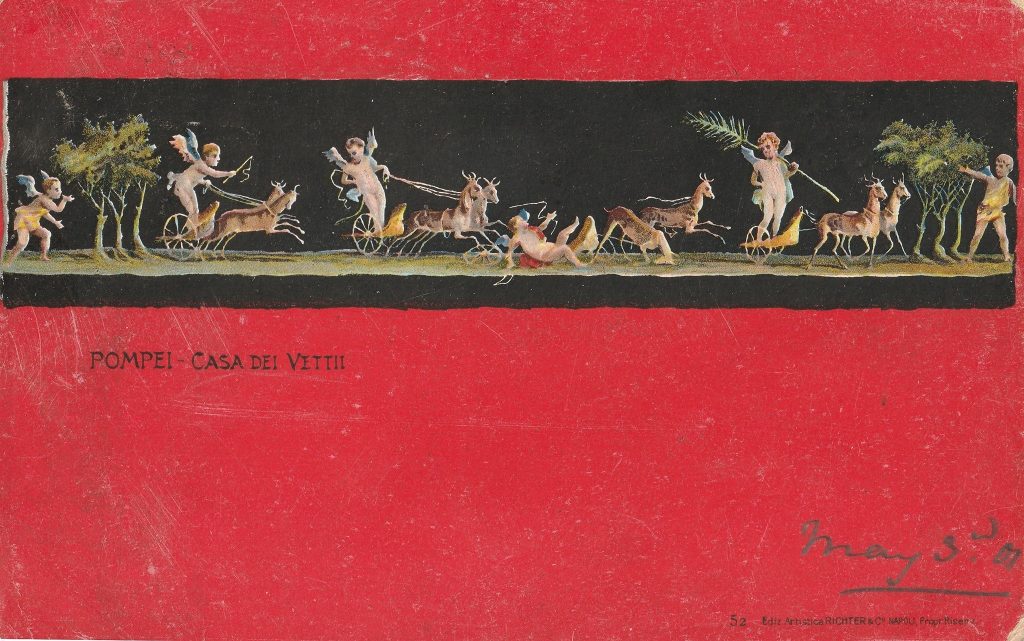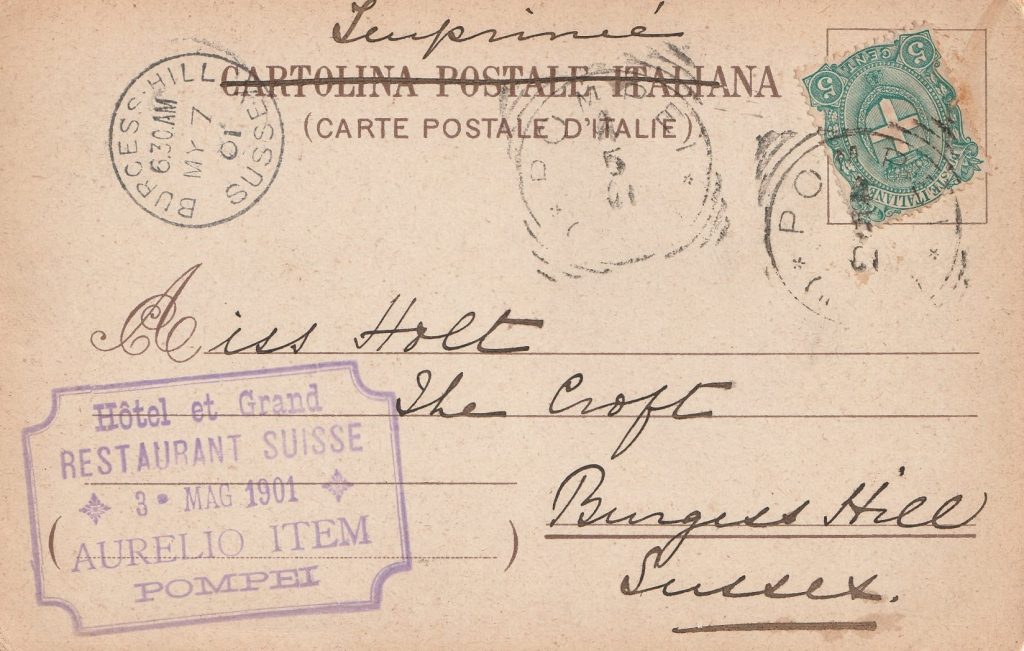Bob Teevan
Aurelio Item
Who, What, or Where?
Answers are the crop researchers harvest. Questions are everywhere. Join the search.

This card dates from the earliest part of the 20th century or perhaps a few years before.
One of my excuses to buy a card is, “I have been there.” I have visited the ruined city of Pompeii so I can justify my purchase. Published by Richter & Company of Napoli, (Italy), it is titled Pompei – Casa Dei Vettii. The image is a popular one of Cupid’s Hunt, and I believe it to be a frieze from a wall within the Vettii property. The face does not interest me since the only marking is a handwritten date May 3rd ’01.

The real reason I wanted it is that in addition to the postmarks it had a nice hotel cachet which suggested that it was mailed in a hotel.
It would seem that on May 3, 1901, the un-signed sender selected this card and addressed it to Miss Holt at The Croft, Burgess Hill, Sussex. I suspect they then took it to the hotel’s concierge and requested it be posted on his behalf. It has been suggested to me that the concierge will have charged the sender ten cents for postage as that was the current rate for sending postcards in Italy. The concierge will then have scored out the words Cartolina Postale Italiana and replaced them with Imprime which changed the item from a postcard to printed matter. This was of no benefit to the sender although the cost of sending printed matter through the mail was five cents which enabled the concierge to place a 5-cent stamp on the card and slip five cents into his pocket.
Before taking the card to a mailbox the concierge placed the hotel’s cachet on the card and as you can see this was done on May 3, 1901, at the Hotel et Grand Restaurant Suisse, Pompeii which was more commonly known as the Hotel Suisse. This stamp also suggests that it is an Aurelio Item, whatever that is.
The card then goes to the Post Office where I initially thought a careless postal clerk had used a squared circle postmark twice because he missed the stamp the first time. I am however advised that in Italy it was common practice to cancel both the postage stamp and the card. The card then continued its journey until it reached Burgess Hill. It was most likely delivered to Miss Holt on the morning of May 7th as it was stamped as received there at 6:30 AM on that day.
When I first saw the markings, I thought that a card taking only four days to get from Pompeii to Burgess Hill in 1901 was impressively quick. It was actually quicker since it took the concierge two days to get it from the hotel to the post office. Why did it take the concierge so long to pass it on? Was it because it was an Aurelio Item or was it because he was off spending his pocketed 5 cent coins on a nice red wine?
Miss Holt had only recently moved into The Croft at Burgess Hill as in April 1900. The census shows she was living at Silverdale Road, Burgess Hill with her widowed mother, Frances Holt, 69, who was of independent means and four domestic servants. The Miss Holt was Frances Sarah Ann Elizabeth (S. A. E.) Holt, 42, unmarried and having no occupation. I found her in the census records of 1861 through to 1901 although I cannot find her in 1911. She was baptized on April 12, 1859 in Harrogate. Her death was registered in Brighton in April 1936.
The Hotel Suisse was a popular hotel in Pompeii and while it has several dozen references in the newspapers the majority of these relate to an accident on Vesuvius in July 1891. It would appear that two friends, Dr. Silva Jardim, of Rio de Janeiro and a gentleman named Carneiro arrived in Pompeii from Naples on July 1.
The following is taken from a longer article in the Nottingham Evening Post in July 1891:
After a long visit to the ruins the two friends took a late lunch at the Hotel Suisse, and then sat smoking cigarettes on the terrace, which commands a full view of Vesuvius.
“Come what may,” Silva exclaimed all at once, “I must go up there.”
“No, no,” Carneiro replied, “you would not enjoy it, with this heat; besides, where can we find a guide?”
Silva would not be dissuaded, however. After some little trouble he succeeded in finding a non-official guide, who declared that he knew Vesuvius as he did his own house.
“Come on, Carneiro,” said Silva, looking for his hat!
“Remember,” replied the latter, “to whom entrust our lives; this man is not an official guide.”
“Dio mio, what nonsense, come let us start,” said Silva.
So, they went; Silva keeping always about twenty yards ahead of his companion. As they approached the crater the climbing became very difficult. Carneiro and the guide called frequently to Silva not to go far without stopping for them. The only reply was “Look, look, Carneiro, what flames and smoke. Now I can understand how Pliny perished here.”
“What a sight! Silva! Silva!,” cried Carneiro as he saw his friend advancing higher, and felt the ground give-way suddenly under his own feet. But Silva had already disappeared. At the same moment Carneiro sank up to his waist in a hollow more than four metres wide and two or three deep. Fortunately, the guide was able to rescue him from his perilous position. Pale as death, and trembling from head to foot, the two gazed in terror at the dense vapor and smoke above them.
“And Silva?, Carneiro asked.
“He is gone,” was the reply.
“Dead?”
The guide threw up his hands in despair and remained silent.
* * *
I wonder how liquid the lunch at the Hotel Suisse was on that fateful day?
* * *
To close, I did discover what an Aurelio Item was. While researching the Hotel Suisse, an article from the Pall Mall Gazette of December 28, 1912, stated: “Some time ago Mr. Aurelio Item, the owner of the well-known Hotel Suisse in Pompeii, commenced to make excavations on a piece of land which he had lately acquired north-west of the buried city. These excavations were made at his own risk and expense, with the permission of the Italian government, and since the attempt proved successful, several other gentlemen who owned land near Vesuvius took a financial interest in the undertaking. Very soon it became evident that luckily, they had struck upon a large villa which, according to all indications, must have belonged to distinguished persons in antiquity. It is situated about one and a half kilometers from the Herculaneum gate of Pompeii, [on] the road to Herculaneum. It is the same street where the well-known villa of Diomede stands, but nearer to the gate of the town.”
So, an Aurelio Item was a person, a hotel owner, whose name would obviously be on the hotel’s cachet!
I so enjoy these additional stories from postcards in our collections. The people who sent them, and to whom, as well as the postmarkings and philatelic history. THANKS VERY MUCH.
Wonder how much of that concierge’s income came from the “tips” he provided himself through such skullduggery as the “printed matter” scam…